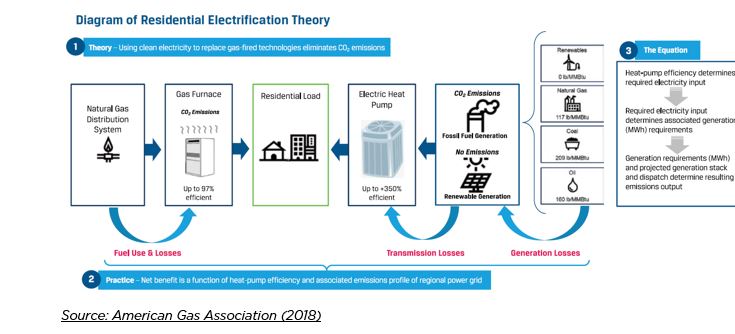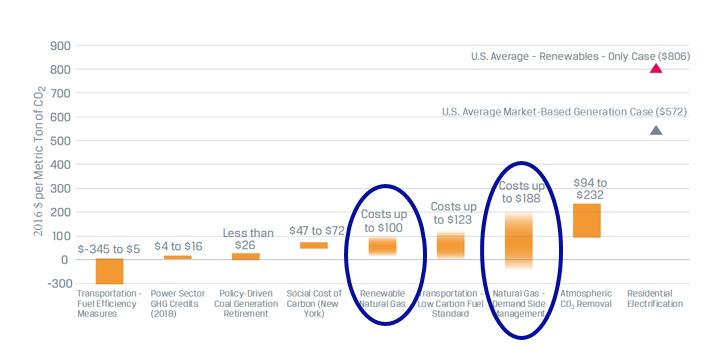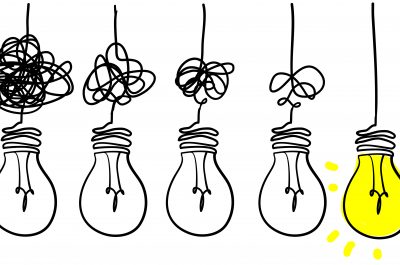Electrify the gas – should we or shouldn’t we?
A large proportion of Australian households use gas for heating, cooking and hot water. The fuel contributes to about two per cent of the nation’s greenhouse gas emissions. In comparison, the emissions associated with electricity consumption at home contribute almost 20 per cent of national emissions. As the economy decarbonises to meet global climate change commitments, Australian households will also need to cut back on their emissions. In terms of household gas, there are two options to achieve this. The first promotes replacing gas with electrical appliances (electrification) on the basis that electricity will be decarbonised in the long term and provide emission-free energy services. The second option identified in Gas Vision 2050 is to decarbonise the fuel distributed in gas networks. This will not only result in emission-free energy, but also make use of our vast existing gas infrastructure and reduce the pressure on our electricity networks.
The following diagram illustrates the two options. From the left hand side, the gas supplied can be decarbonised, while electrification is illustrated from the right hand side towards the centre image of the residential load.

Advocates of the electrification scenario often use simplified arguments and ambitious assumptions claiming that cost and emissions savings are possible. Unfortunately, this is not often the case as it does not account for increased systems costs.
Two recent international studies provide a detailed analysis of electrification.
Centre on Regulation in Europe: Gas and the electrification of heating & transport: scenarios for 2050
This study outlines the consequences that electrification of heating and transport has for the electricity and gas sectors, for carbon (CO2) emissions and the overall societal costs for five countries in the EU with varying energy mixes. The countries assessed are Austria, Belgium, France, Germany and the Netherlands.
American Gas Association: Implications of policy driven residential electrification.
This report addresses several key questions regarding potential costs and benefits of mandated residential electrification as promoted by some policy makers and environmental advocates. It addresses the following questions:
- Will policy-driven residential electrification actually reduce emissions?
- How will policy-driven residential electrification impact natural gas utility customers?
- What will be the impacts on the power sector and on electric transmission infrastructure requirements?
- What will be the overall cost of policy-driven residential electrification?
- How do the costs of policy-driven residential electrification compare to the costs of other approaches to reducing emissions?
Overall results
While the detailed results of the two studies differ, the conclusions are very similar.
The main conclusion is that electrifying the gas network is not a practical solution, as it will require significant additional investment in electricity infrastructure (generation, transmission and distribution) generally leading to higher, overall energy bills for consumers. Moreover, electrification of domestic gas is a very expensive way for reducing CO2 emissions, and alternatives such as injecting renewable gases into networks are available at much lower cost.
Detailed results from the two reports are compared in the table at the end of this article.
Abatement options
The American Gas Association compares the cost of abatement of policy driven electrification with other options to reduce emissions, as shown below. Residential electrification would cost between US$572 and US$806/ ton CO2.

The chart shows other options (in blue circles) for reducing emissions from gas networks that are much more cost effective than residential electrification. These include demand side management of natural gas such as increased efficiency in appliances and energy use within homes and the use of renewable gases. The renewable gas option is being pursued by many gas distribution businesses worldwide and Australian gas businesses are demonstrating these technologies using biogas and hydrogen.
Hopefully the evidence provided in these two reports will inform policy makers about the effectiveness of electrification options and provide a more balanced argument to emission reductions from the residential sector.
Policy settings
While the results of the above studies cannot simply be scaled to the Australian energy system, the general conclusions can be used to guide policy settings. The overall conclusions are similar for a broad range of countries with varying energy mixes as shown in the CERRE and AGA studies.
Energy Networks Australia supports technology neutral policy settings. The push by some advocates to promote policy-driven electrification could in fact lead to increased energy costs while producing limited emission reductions, or may actually result in increasing emissions. A technology neutral approach will allow different technologies to be introduced to meet local conditions. For example, heat pump technology may work well in northern Australia, while decarbonising gas networks – through renewable gases – may be a better approach to reducing emissions in Victoria instead of electrification driven policies.
Table 1: Comparison of results of the CERRE and AGA Reports
| General conclusions | CERRE report results | AGA report results |
|---|---|---|
| Gas demand in power generation increases in the electrification scenarios. | The demand for gas from the residential sector decreases as electrification progresses, but because of the planned phasing out of coal and nuclear generation and limited increase in renewables, gas demand rises in the power market. | The potential reduction in emissions from the residential sector is partially offset by an increase in emissions from the power generation sector, even in a case where all incremental generating capacity is renewable. |
| Additional capacity of gas-fired power generation increases and additional transmission is required. | In most countries, securing supply on high-demand days with little wind or solar power supply, would require significant investments.
In France, current gas-fired capacity would need to increase by 7 times. In Belgium and Germany, the increase in gas-fired generation capacity would also be of the order of 3 or 4 times the current installed capacity. |
Between 132 gigawatt (GW) and 320 GW of additional generation capacity required at a cost of between $102 and $319 billion.
An additional $53 to $107 billion of associated transmission system upgrades. |
| Electricity grid needs to be strengthened to meet the additional demand. | In 2050, in the scenario of full electrification, the electricity grid capacity would have to increase in BE by 70 per cent, in NL by 50 per cent, in AT by 34 per cent, in FR by 35 per cent and in DE by 37 per cent. Except for NL and possibly BE, the capacity of the gas networks will also have to be extended. | Widespread policy-driven residential electrification will lead to increases in peak electric demand, and could shift the US electric grid from summer peaking to winter peaking in every region of the country, resulting in the need for new investing in the electric grid including generation capacity, transmission capacity and distribution capacity. |
| Cost to customer will increase in electrification scenarios. | The net cost of electrification ranges between 0.5 and 7 per cent of GDP and €19 billion for Belgium, €15 billion for France to €144 billion for GE. | Policy-driven electrification would increase the average residential energy-related costs (amortised appliance and electric system upgrades and utility bill payments) of affected households by between US$750 and US$910 per year, or about 38 per cent to 46 per cent.
Total energy related costs range between US$590 billion to US$1.2 trillion. |
| Emission reductions are insufficient to meet agreed targets by 2050. | The emissions reduction target of 80 per cent will not be met. Emissions from the sector will only reduce by 11 per cent in BE, 62 per cent in AT, 70 per cent in DE, 48 per cent in FR and 40 per cent in NL | By 2035, direct residential natural gas will account for less than 4 per cent of total greenhouse gas emissions. Reductions from policy-driven residential electrification would reduce GHG emissions by 1 to 1.5% of US GHG emissions in 2035. |
| Cost of abatement for electrification is more expensive than other abatement options. | The cost per ton of CO2 reduction would be €250 for NL, €146 for BE, €142 for DE, €78 for France and €54 for AT. | The average cost of US greenhouse gas emissions reductions achieved by policy-driven residential electrification would range between US$572 and US$802 per metric ton of CO2 reduced, which is significantly higher than the estimated cost of other GHG reduction options. |



